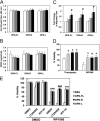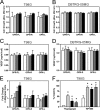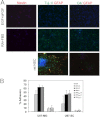Thrombin-cleaved fragments of osteopontin are overexpressed in malignant glial tumors and provide a molecular niche with survival advantage
- PMID: 23204518
- PMCID: PMC3561533
- DOI: 10.1074/jbc.M112.362954
Thrombin-cleaved fragments of osteopontin are overexpressed in malignant glial tumors and provide a molecular niche with survival advantage
Abstract
Osteopontin (OPN), which is highly expressed in malignant glioblastoma (GBM), possesses inflammatory activity modulated by proteolytic cleavage by thrombin and plasma carboxypeptidase B2 (CPB2) at a highly conserved cleavage site. Full-length OPN (OPN-FL) was elevated in cerebrospinal fluid (CSF) samples from all cancer patients compared with noncancer patients. However, thrombin-cleaved OPN (OPN-R) and thrombin/CPB2-double-cleaved OPN (OPN-L) levels were markedly increased in GBM and non-GBM gliomas compared with systemic cancer and noncancer patients. Cleaved OPN constituted ∼23 and ∼31% of the total OPN in the GBM and non-GBM CSF samples, respectively. OPN-R was also elevated in GBM tissues. Thrombin-antithrombin levels were highly correlated with cleaved OPN, but not OPN-FL, suggesting that the cleaved OPN fragments resulted from increased thrombin and CPB2 in this extracellular compartment. Levels of VEGF and CCL4 were increased in CSF of GBM and correlated with the levels of cleaved OPN. GBM cell lines were more adherent to OPN-R and OPN-L than OPN-FL. Adhesion to OPN altered gene expression, in particular genes involved with cellular processes, cell cycle regulation, death, and inflammation. OPN and its cleaved forms promoted motility of U-87 MG cells and conferred resistance to apoptosis. Although functional mutation of the RGD motif in OPN largely abolished these functions, OPN(RAA)-R regained significant cell binding and signaling function, suggesting that the SVVYGLR motif in OPN-R may substitute for the RGD motif if the latter becomes inaccessible. OPN cleavage contributes to GBM development by allowing more cells to bind in niches where they acquire anti-apoptotic properties.
Figures









Similar articles
-
Thrombin cleavage of osteopontin disrupts a pro-chemotactic sequence for dendritic cells, which is compensated by the release of its pro-chemotactic C-terminal fragment.J Biol Chem. 2014 Sep 26;289(39):27146-27158. doi: 10.1074/jbc.M114.572172. Epub 2014 Aug 11. J Biol Chem. 2014. PMID: 25112870 Free PMC article.
-
Thrombin-activatable carboxypeptidase B cleavage of osteopontin regulates neutrophil survival and synoviocyte binding in rheumatoid arthritis.Arthritis Rheum. 2009 Oct;60(10):2902-12. doi: 10.1002/art.24814. Arthritis Rheum. 2009. PMID: 19790060 Free PMC article.
-
SVVYGLR motif of the thrombin-cleaved N-terminal osteopontin fragment enhances the synthesis of collagen type III in myocardial fibrosis.Mol Cell Biochem. 2015 Oct;408(1-2):191-203. doi: 10.1007/s11010-015-2495-y. Epub 2015 Jun 27. Mol Cell Biochem. 2015. PMID: 26112906
-
Both Full-Length and Protease-Cleaved Products of Osteopontin Are Elevated in Infectious Diseases.Biomedicines. 2021 Aug 13;9(8):1006. doi: 10.3390/biomedicines9081006. Biomedicines. 2021. PMID: 34440210 Free PMC article. Review.
-
Thrombin Cleavage of Osteopontin and the Host Anti-Tumor Immune Response.Cancers (Basel). 2023 Jul 3;15(13):3480. doi: 10.3390/cancers15133480. Cancers (Basel). 2023. PMID: 37444590 Free PMC article. Review.
Cited by
-
Cerebrospinal fluid biomarkers for brain tumor detection: clinical roles and current progress.Am J Transl Res. 2020 Apr 15;12(4):1379-1396. eCollection 2020. Am J Transl Res. 2020. PMID: 32355549 Free PMC article. Review.
-
Osteopontin expression in the brain triggers localized inflammation and cell death when immune cells are activated by pertussis toxin.Mediators Inflamm. 2014;2014:358218. doi: 10.1155/2014/358218. Epub 2014 Nov 24. Mediators Inflamm. 2014. PMID: 25525298 Free PMC article.
-
Liquid biopsies in patients with diffuse glioma.Acta Neuropathol. 2015 Jun;129(6):849-65. doi: 10.1007/s00401-015-1399-y. Epub 2015 Feb 27. Acta Neuropathol. 2015. PMID: 25720744 Free PMC article.
-
Cerebrospinal Fluid Liquid Biopsies in the Evaluation of Adult Gliomas.Curr Oncol Rep. 2024 Apr;26(4):377-390. doi: 10.1007/s11912-024-01517-6. Epub 2024 Mar 15. Curr Oncol Rep. 2024. PMID: 38488990 Review.
-
Thrombin cleavage of osteopontin controls activation of hepatic stellate cells and is essential for liver fibrogenesis.J Cell Physiol. 2019 Jun;234(6):8988-8997. doi: 10.1002/jcp.27571. Epub 2018 Oct 23. J Cell Physiol. 2019. PMID: 30350863 Free PMC article.
References
-
- Han M. H., Hwang S. I., Roy D. B., Lundgren D. H., Price J. V., Ousman S. S., Fernald G. H., Gerlitz B., Robinson W. H., Baranzini S. E., Grinnell B. W., Raine C. S., Sobel R. A., Han D. K., Steinman L. (2008) Proteomic analysis of active multiple sclerosis lesions reveals therapeutic targets. Nature 451, 1076–1081 - PubMed
-
- Wang K. X., Denhardt D. T. (2008) Osteopontin. Role in immune regulation and stress responses. Cytokine Growth Factor Rev. 19, 333–345 - PubMed
-
- El-Tanani M. K., Campbell F. C., Kurisetty V., Jin D., McCann M., Rudland P. S. (2006) The regulation and role of osteopontin in malignant transformation and cancer. Cytokine Growth Factor Rev. 17, 463–474 - PubMed
Publication types
MeSH terms
Substances
Grants and funding
LinkOut - more resources
Full Text Sources
Other Literature Sources
Medical
Research Materials
Miscellaneous

